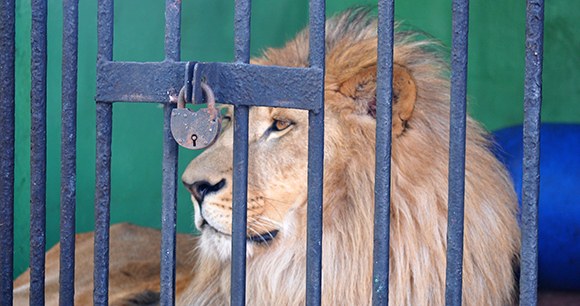
The Big Cat Public Safety Act (Public Law No: 117-243) was signed into law by President Biden on December 20, 2022.
What the Law Does
The Big Cat Public Safety Act (H.R. 263/S. 1210) was introduced in the 117th Congress by Representatives Mike Quigley (D-IL) and Brian Fitzpatrick (R-PA) and Senators Richard Blumenthal (D-CT), Susan Collins (R-ME), Tom Carper (D-DE), and Richard Burr (R-NC). It is a commonsense solution to the dangerous and cruel problems associated with private ownership of big cats and direct contact activities like cub petting. The wild animals used for petting and photo-taking encounters, and those imprisoned in basements or backyards as pets, not only suffer immensely, but also pose a serious risk to human safety.
The law amends the Captive Wildlife Safety Act to prohibit the private possession of lions, tigers, leopards, cheetahs, jaguars, cougars, or any hybrid of these species. This prohibition is narrowly focused on pet big cats and exempts zoos, sanctuaries, and universities. Current owners are grandfathered in and are simply required to register their animals to ensure that first responders and animal control officers are aware of the presence of such animals in their communities. The law also restricts direct contact between the public and big cats.
Overview of the Problem
Due to a lack of federal oversight, there was no reliable way to track the trade in big cats as pets. Nobody knows exactly how many dangerous big cats were kept in private hands, or where they are.
A small number of unscrupulous facilities offered cub petting or photo opportunities, which fueled a vicious cycle of breeding and dumping cubs and was a primary source of big cats for the pet trade. After they outgrew their usefulness and profitability at about 12 weeks old, these cubs were funneled into the exotic pet trade, sold to another disreputable exhibitor, or killed to supply the black market trade for wildlife parts.
This problem required a federal solution. With some states banning private ownership of big cats and other states imposing partial restrictions or no restrictions whatsoever, this regulatory patchwork failed to protect public safety and animal welfare.
Public Safety Implications
Big cats cannot be domesticated. Unlike companion animals who have been domesticated over centuries, big cats always retain their natural instinct to hunt and attack, no matter how they are raised.
There have been hundreds of dangerous incidents involving captive big cats in the United States. Big cats have taken the lives of at least five children and caused serious injuries to others, including lost limbs and other traumatic injuries. Captive big cats have also killed at least 20 adults and mauled scores of others.
Among the most dramatic incidents was an October 2011 incident in Zanesville, Ohio, in which a private exotic animal owner released dozens of big cats into a community, requiring law enforcement to kill the cats—and risk their own lives—for the sake of public safety.
Animal Welfare Implications
Big cats are wild animals who suffer when people attempt to keep them as pets. By the time they are fully grown, they are too strong and dangerous for private owners to manage. Consequently, the animals are frequently neglected and locked away in barren cages with barely enough room to move. Proper care and diet are also very expensive, so the cats are often malnourished and unhealthy.
Big cats bred for profit can suffer from deformities due to selective breeding for certain physical traits. A prime example is the purposeful breeding for white tigers—which are not a distinct subspecies of tiger but merely an aberrant color variation. Captive white tigers are regularly inbred, and this has led to serious congenital defects, including cleft palates, cataracts, club feet, and near-crippling hip dysplasia. This is done solely for cosmetic reasons and serves no conservation goals.
Direct contact between the public and cubs fueled the demand for big cats as pets and caused enormous suffering. The breeders often separated mother cats from their cubs immediately after birth, leading to physical and psychological harm, as it interrupted the mother-cub bonding process and taxed cubs’ underdeveloped immune systems. It is stressful and frightening for the cubs to be passed around in crowds of people, and the handlers often physically abused them to force them to “behave.”
Conservation Implications
Private ownership of big cats does not contribute to conservation goals. Privately owned big cats from the United States cannot be released into the wild because they lack the skills to survive; consequently, confiscated big cats must be placed in other captive environments.
Ending the continuous breeding of big cats for cub handling and ending the pet trade in big cats lends the United States greater credibility in conservation efforts abroad. State Department efforts to end cruel “tiger farming” elsewhere were hamstrung by the existence of a big cat crisis in our own nation.
Private possession and rampant breeding of big cats may also contribute to illegal international wildlife trafficking. Illegal trade in big cat parts such as skins and bones is big business, and there was no way to know how many US-born big cats are exploited and killed for the black market trade.